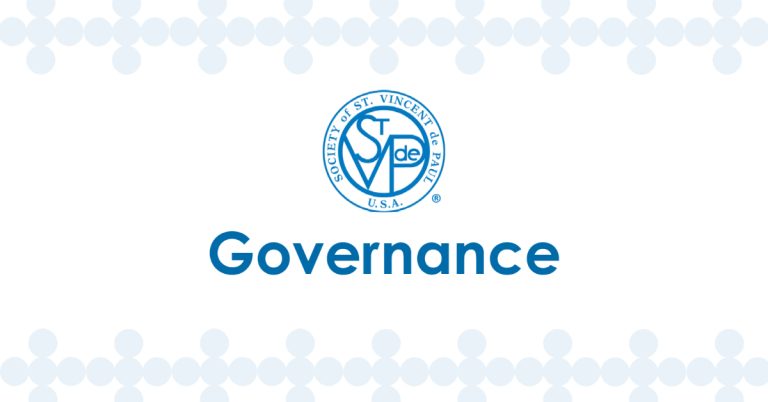We have noted several times in this Manual that progress takes time and patience. Gaining new members, increasing contributions, attaining spiritual maturity, and developing a network of relationships happen only slowly, over time. Once you have made that commitment in effort and prayer, would it not be a shame to lose what you worked so hard to build?
You retain people by helping them do things that warm their hearts and enrich their souls. Then they will make the personal commitment to continue.
An important point to remember is that a happy, dedicated member is one who knows what is expected and also knows how and why what he/she does is important to the Society and those in need. The heart of retention is the long-range feeling that the Society and its works are individually fulfilling.
NEW MEMBERS
Gaining a new member is like finding a diamond in the slag at the Kimberly mines. You have no idea of its real value until you chip away the exterior to reveal its inner composition (get to know her/him), and spend time polishing its surface (provide training, motivation and direction). A hesitant retired accountant could become your most dynamic home visit team member, engaging even the most cynical of guests in fervent prayer. A quiet young parishioner may have the potential to be your successor as Conference president.
How do you retain these diamonds in the rough?
- Assign them a mentor. Assign them someone who will work with them for a while — at least four to six months. Preferably an experienced Vincentian of the same sex. To be considered for the role of mentor, a member should be well experienced in the Society (it would be wrong here to define a number of years of experience), have participated in sufficient number of home visits to have experienced a wide variety of circumstances, and has attended the Ozanam Orientation.
- Assign them something to do right away, even if it appears trivial, like organizing the shelves in your pantry. Explain how it is important to your overall work (you must meet the health code or risk the loss of your pantry) and that you will be moving them to other, more important work soon.
- Assign them a meaningful responsibility quickly. Don’t break your promise from the above item. Give them something important to do, preferably Home Visits with an experienced Vincentian.
- Provide them with training (local) as soon as possible for specialized positions (answering the phone, packing food boxes, picking up bread). Team them up with an experienced Vincentian for home visits or food delivery. People learn best from observing others.
- Get them into Ozanam Orientation training within three months. Never send them alone; send them with someone they know. Anxiety and confusion runs high among new members; having a friend with you helps clear away those bottlenecks to participation and development.
- Help them feel they are members of a big family Invite, but don’t force, them to interesting District Council and/or Diocesan Council. Offer to pick them up and drive them to the first couple functions; encourage the creation of car pools to take groups of members to functions. Mix new members with old-timers whenever possible. It gives confidence to the newcomers and new vitality to older Vincentians.
- Don’t exclude non-Catholics. We are an organization which is “Catholic in character.” Anyone who shares the objectives of the Society is eligible to join. A real measure of your effectiveness is when non-Catholics join, perceiving that SVdP is not only an effective organization serving the poor, but a means of living out the tenets of their Christian (or monotheistic) faith. Recent Popes have all stressed our obligation to practice ecumenism; let’s not drop the ball in the field.
Next, consider the suggestions, below, for existing members.
EXISTING MEMBERS
Yes, new members are essential for growth, vitality and the future. But existing members are your backbone, source of experience, the people who will guide and mentor the newcomers. They need your attention too.
- Keep your members busy. More members drop out because they don’t think they’re needed than because they’re overworked. Keep them busy. Get them involved in the whole picture. Let them know what’s going on, locally, at the District Council/Diocesan Council level, even nationally. Get someone to handle the “telephone tree” and make sure everyone gets a call when help is needed. Even if someone says “sorry” again and again, don’t give up on getting them involved – keep calling.
- Form committees and ask everyone to serve on at least one and, hopefully, two. Good ones are:
- Information and Referral — Keep the material in your Information and Referral Manual (Sources of Assistance) complete and up-to-date.
- Food Procurement — Track what food is available at food bank and at alternate food sources; how and when your monthly allotment and other food supplies will be picked up, unloaded, and shelved.
- Food Processing — Arrange for vouchers for milk, bread, fresh fruits, and produce; repackage laundry detergent, and odd items the Conference receives in bulk.
- Furniture Registry — Establish and maintain a list of donated, used furniture available from parishioners for guests when needed. Try to arrange for temporary storage. Match up with requests from guests.
- Food Pantry — Keep the pantry clean and the shelves stocked. Some Conferences pre-pack food boxes by size of family.
- Social events — Arrange pot luck dinners, outings, parties, etc., for all members spaced throughout the year.
- Spirituality — Make a calendar for the year with plans for the religious days related to our Society. Coordinate activities with neighboring Conferences.
- Communications— make sure the parish bulletin has an item about SVdP every week, or the bulletin board has a display, or the newsletter is properly prepared for bulk-rate mailing.
- Correspondence — handle the correspondence of the Conference, communicating with other parish groups, sending get well and condolence cards, thank you notes to contributors, etc.
- Projects or Events committees — Back to School, Postal Food Drive, Roses for Life, Boy Scout Food Drive, Christmas Gift and Food Basket, etc.
- Encourage continuing education. A person never stops learning. The Diocesan Council can provide you with many ideas and resources for spiritual growth and Vincentian development for your members. Included are:
- The Ozanam Orientation provides basic orientation and essential background and is obligatory for new members and those serving as officers. This one day workshop includes SVdP history, spirituality, philosophy, organization, activities, Home Visits, etc. Even experienced members have found this program very beneficial.
- Serving in Hope has seven modules with multiple lessons in each. Modules include: Our Vincentian Vocation, Our Vincentian Spirituality, Our Vincentian Heritage, Our Vincentian Mission, Our Vincentian Rule, Our Vincentian Conference and the Home Visit. Each lesson contains study, reflection, and small group discussion. The formation guides and videos can be ordered from the National Council office.
- Voice of the Poor. This educational guide on advocacy is available through the National Council office.
- Diversity. “A Vincentian Guide to Diversity/Multicultural Issues” is available through the National Council office.
- Attend Home Visit Training, Spiritual Advisor Training
- Attend Retreats, Region Meetings
Be cautious about discouraging members from moving away from being actively involved. People’s lives change, sometimes often and at inconvenient times. Women get pregnant and have babies and their lives take difficult turns. Adults find a parent has Alzheimer’s or a child has ALS. Members who are actively involved who must ‘withdraw’ or ‘take time off’ should never be made to feel ‘guilty’ about the change.
Vincentians who leave active service on a positive note are more likely to return when their lives change again and/or to continue to help out in other ways (financially, volunteering for special projects, etc.).
Build the role of Associate Membership. Continued participation of the Vincentian, in any role, is the key to eventually getting the person back into an active role.
- Involve your regular donors. Regular donors are equal partners in the Society. We are a union of willing hands (Active Members), caring hearts and helping hands (Associate Members) and generous almsgivers (regular donors). Each is separate but equal.
Many people are afraid to participate, afraid to meet the poor. They choose to discharge their responsibility to help the poor by writing you a check. While you may need their check to help the poor, your objective should be to tactfully get them involved in person-to-person contact with those in need. Let them find out it’s not stressful when working with another, experienced parishioner. Help them find how it gives them a warm and fuzzy feeling.
Get them into Home Visits the easy way — with the Back to School program, Thanksgiving or Christmas food box distributions that some Conferences put together.
Include regular donors in as many activities as you can, especially Masses on feast days of St. Vincent and Blessed Frederic, food and clothing drives, etc. Send all major communications and newsletters to them. This can sometimes convert them to Associate and then Active Full Membership.


